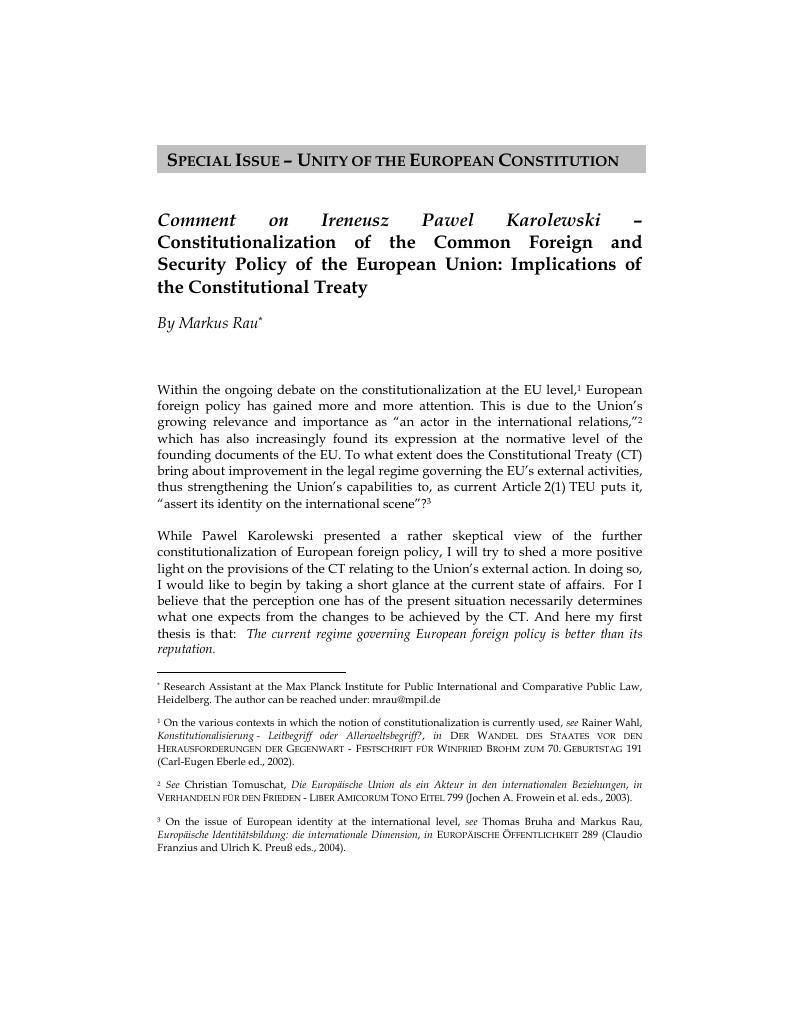No CrossRef data available.
Article contents
Comment on Ireneusz Pawel Karolewski – Constitutionalization of the Common Foreign and Security Policy of the European Union: Implications of the Constitutional Treaty
Published online by Cambridge University Press: 06 March 2019
Abstract

- Type
- Part III: Sectoral Differentiation in the Constitution
- Information
- German Law Journal , Volume 6 , Issue 11: The Unity of the European Constitution: 2nd German-Polish Seminar on the Constitutional Law of the European Union , 01 November 2005 , pp. 1667 - 1671
- Copyright
- Copyright © 2005 by German Law Journal GbR
References
1 On the various contexts in which the notion of constitutionalization is currently used, see Rainer Wahl, Konstitutionalisierung – Leitbegriff oder Allerweltsbegriff?, in Der Wandel des Staates vor den Herausforderungen der Gegenwart – Festschrift für Winfried Brohm zum 70. Geburtstag 191 (Carl-Eugen Eberle ed., 2002).Google Scholar
2 See Tomuschat, Christian, Die Europäische Union als ein Akteur in den internationalen Beziehungen, in Verhandeln für den Frieden – Liber Amicorum Tono Eitel 799 (Jochen A. Frowein et al. eds., 2003).Google Scholar
3 On the issue of European identity at the international level, see Thomas Bruha and Markus Rau, Europäische Identitätsbildung: die internationale Dimension, in Europäische Öffentlichkeit 289 (Claudio Franzius and Ulrich K. Preuß eds., 2004).Google Scholar
4 See Treaty Establishing the European Community, Article 133, Nov. 10, 1997, 1997 O.J. (C 340) 3 [hereinafter TEC].Google Scholar
5 Article 174(4) TEC.Google Scholar
6 Articles 181 and 181a TEC.Google Scholar
7 See Bruha and Rau, supra note 3, at 310-311.Google Scholar
8 For a detailled analysis of the legal foundations and current activities of the EU in the field of international human rights policy, see Thomas Bruha and Markus Rau, Bedeutung der Grundrechte der EU für Drittstaaten, in Handbuch der Europäischen Grundrechte (Sebastian Heselhaus and Carsten Nowak eds., forthcoming).Google Scholar
9 McCarver v. North Carolina, 533 U.S. 975 (2001).Google Scholar
10 Brief for the European Union as Amicus Curiae in Ernest Paul McCarver v. State of North Carolina, available at http://www.eurunion.org/legislat/DeathPenalty/EUActionsUSCases2001.htm.Google Scholar
11 On this issue, especially against the background of the Supreme Court's later decision in Atkins v. Virginia, 536 U.S. 304 (2002), see Lutz Eidam, Mentally Retarded Offenders and the Death Penalty – The Latest Supreme Court Ruling and Possible European Influences, 4 German Law Journal 491 (2003).Google Scholar
12 Council of the European Union, European Guidelines on Human Rights Dialogues, 13 December 2001.Google Scholar
13 See, e.g., Thym, Daniel, The Institutional Balance of European Foreign Policy in the Treaty establishing a Constitution for Europe, WHI-Paper 13/04, 3, available at http://www.rewi.hu-berlin.de/WHI/papers/whipapers1304/paper1304.pdf; Daniel Thym, Die neue institutionelle Architektur europäischer Außen und Sicherheitspolitik, 42 Archiv des Völkerrechts 44, 45-46 (2004).Google Scholar
14 See Bruha, Thomas and Rau, Markus, Verfassungsrechtliche Dimensionen europäischer Außenpolitik, Sec. III (“Materiell-verfassungsrechtliche Bindungen europäischer Außenpolitik”), in Die Europäische Union im Wandel: Innere Verfasstheit und Äußere Handlungsfähigkeit (Thomas Bruha and Carsten Nowak eds., forthcoming); Bruha and Markus Rau, supra note 3, at 313-317. For a discussion of the current constitutional constraints regarding European foreign policy against the background of the Iraq crisis of 2003, see Franz C. Meyer, Angriffskrieg und europäisches Verfassungsrecht. Zu den rechtlichen Bindungen von Außenpolitik in Europa, 41 Archiv des Völkerrechts 394 (2003).Google Scholar
15 On the Union Foreign Minister, see Thym, The Institutional Balance, supra note 13, at 14-17; Thym, Die neue institutionelle Architektur, supra note 13, at 60-64.Google Scholar
16 For further details, see Bruha and Rau, supra note 14, at Sec. II (“Kompetenzabgrenzung im Bereich der auswärtigen Gewalt der EU”).Google Scholar
17 See Thym, , Die neue institutionelle Architektur, supra note 13, at 50.Google Scholar
18 In respect of German constitutional law, see, e.g., Rüdiger Wolfrum, Kontrolle der auswärtigen Gewalt, 56 Veröffentlichungen der Vereinigung der deutschen Staatsrechtslehrer 39 (1997).Google Scholar
19 See Hilf, Meinhard and Schorkopf, Frank, Das Europäische Parlament in den Außenbeziehungen der Europäischen Union, 7 Europarecht 185, 200-201 (1999).Google Scholar
20 See Cremer, Hans-Joachim, Anmerkungen zur GASP – Eine rechtspolitische Perspektive, 31 Europäische Grundrechte-Zeitschrift 587, 589-590 (2004).Google Scholar




